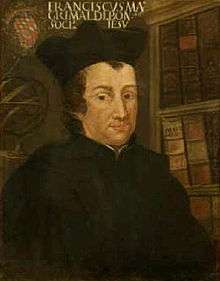Francesco Maria Grimaldi
Francesco Maria Grimaldi (2 April 1618 – 28 December 1663) was an Italian Jesuit priest, mathematician and physicist who taught at the Jesuit college in Bologna. He was born in Bologna to Paride Grimaldi and Anna Cattani.[1]
Francesco Maria Grimaldi | |
|---|---|
 | |
| Born | 2 April 1618 |
| Died | 28 August 1663 (aged 45) |
| Nationality | Italian |
| Other names |
|
| Known for | free fall, diffraction |
| Scientific career | |
| Fields | Mathematics, Physics |
Work
Between 1640 and 1650, working with Riccioli, he investigated the free fall of objects, confirming that the distance of fall was proportional to the square of the time taken. Grimaldi and Riccioli also made a calculation of the gravitational constant by recording the oscillations of an accurate pendulum.[2]
In astronomy, he built and used instruments to measure lunar mountains as well as the height of clouds, and drew an accurate map or, selenograph, which was published by Riccioli and now adorns the entrance to the National Air and Space Museum in Washington D.C.
He was the first to make accurate observations on the diffraction of light[3][4] (although by some accounts Leonardo da Vinci had earlier noted it[5]), and coined the word 'diffraction'. Through experimentation he was able to demonstrate that the observed passage of light could not be reconciled with the idea that it moved in a rectilinear path. Rather, the light that passed through the hole took on the shape of a cone. Later physicists used his work as evidence that light was a wave, and Isaac Newton used it to arrive at his more comprehensive theory of light. He also discovered what are known as diffraction bands.[6]
Publications
- Physicomathesis de lumine, coloribus, et iride, aliisque annexis (published 1665)
See also
- List of Jesuit scientists
- List of Roman Catholic scientist-clerics
Giusy Petruzzelli, La luce e i colori. Il caso Grimaldi tra scienza e fede, Bari 2012.
References
- Hockey, Thomas (2009). The Biographical Encyclopedia of Astronomers. Springer Publishing. ISBN 978-0-387-31022-0. Archived from the original on 2013-02-03. Retrieved August 22, 2012.
- J.L. Heilbron, Electricity in the 17th and 18th Centuries: A Study of Early Modern Physics (Berkeley: University of California Press, 1979), 180.
- Francesco Maria Grimaldi, Physico mathesis de lumine, coloribus, et iride, aliisque annexis libri duo (Bologna ("Bonomia"), Italy: Vittorio Bonati, 1665), pp. 1–11 (in Latin).
- Florian Cajori (1899). A history of physics in its elementary branches: including the evolution of physical laboratories. The Macmillan Company. pp. 88–. Retrieved 14 August 2011.
- Guglielmo Libri, Histoire des sciences mathematiques en Italie Archived 2006-11-28 at the Wayback Machine (1840)
- Thomas E. Woods (2005). How the Catholic Church built Western civilization. Regnery Publishing. pp. 105–. ISBN 978-0-89526-038-3. Retrieved 14 August 2011.
External links
| Wikiquote has quotations related to: Francesco Maria Grimaldi |

- Grimaldi's (1665) Physico-mathesis de lumine - digital facsimile from the Linda Hall Library